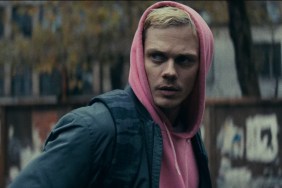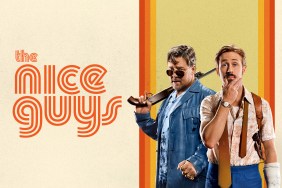
9 out of 10
Cast:
Samuel L. Jackson as Major Marquis Warren
Kurt Russell as “The Hangman” John Ruth
Jennifer Jason Leigh as Daisy Domergue
Walton Goggins as Chris Mannix
Demián Bichir as Bob
Tim Roth as Oswaldo Mobray
Michael Madsen as Joe Gage
Bruce Dern as General Sanford “Sandy” Smithers
James Parks as O. B. Jackson
Dana Gourrier as Minnie Mink
Zoë Bell as Six-Horse Judy
Lee Horsley as Ed
Gene Jones as Sweet Dave
Keith Jefferson as Charlie
Craig Stark as Chester Smithers
Belinda Owino as Gemma
Channing Tatum as Jody Domergue
Directed by Quentin Tarantino
The Hateful Eight Review:
The heart of all existential dread is the unknown, either through a lack of meaning or an inability to comprehend meaning, and nothing is so dreadful as other people (Or at least so says Quentin Tarantino and anyone else who’s ever worked in the crime genre). The dread comes not from strangers but from the people we think we know, the ones to whom we are willing to let down our defenses and thus create the greatest threat to our hearts and lives.
Because somewhere in our heart of hearts we recognize the essential fact that all people are mysteries, that no one is knowable and everyone is capable of anything, even murder. In that sense, the people who actually commit such crimes may be the safest as at least everyone knows what they’re about, though that’s likely cold comfort to their victims or the criminals themselves least ways not after they’ve come under the hand of a man like “The Hangman” John Ruth (Russell).
“The Hangman,” so called, because ‘when he catches you, you hang,’ and few villains who’ve crossed his path have been in as great a need of a good hanging as Daisy Domergue (Leigh). The problem, as several helpful souls point out, in transporting live criminals as opposed to dead ones, is it gives desperate people and their friends ample time to affect a rescue.
Which sounds like an obvious cue for a rousing chase and gunplay amid the odd insert of interesting, well-observed character work, but there is very little which is obvious in The Hateful Eight. Eschewing the plot momentum and heavy style of his earlier works, Tarantino has devised a character-focused murder mystery he can draw out into (chapter divides aside) what is essentially a two-hour scene. Shot in Panavision Ultra 70mm.
When a sudden blizzard traps Ruth and Daisy in a mountain outpost with a handful of other colorful individuals already taking respite there, Ruth quickly and correctly surmises that at least one of them is there to free Domergue. What follows is a good old-fashioned locked room mystery (bolstered by a menacing score from Ennio Morricone), one where an essential understanding of the personalities involved is the plot.
Mysteries of this type are ultimately about the basic unknowableness of human beings and how this is a source of great terror and great redemption as individuals who seem to have nothing in common can and do form fast bonds. In this sense, The Hateful Eight is the apotheosis of modern Tarantino as he continues to pick at the use of slow burn character development he first toyed with in Jackie Brown.
The decision of Tarantino and cinematographer Robert Richardson (Kill Bill) to film in 70mm seems strange (at least at first blush) considering that the bulk of the film takes place not just indoors but within a wooden shack with a single room offering limits to how large a canvas can be painted (barring some stirring wintry mountainscapes early on). Combined with Tarantino’s proclivity for close ups especially during long character moments and it becomes even stranger.
Much of that is because Tarantino is intending to lie to you. He is going to put the entire screen on view and leave it up for scrutiny and still do tricky things at the sides which gradually become more and more important. Fortunately for Ruth, he’s got back up of his own in the form of a pair of Civil War veterans he crossed paths with and it’s up to three of them to figure out which of these things is not like the other … unless they’re plants too.
Tarantino’s typical solid hand with actors is on full view — much of it is in the casting of course and a number of Tarantino familiars are on view — but anyone who can get a solid, nuanced performance from Channing Tatum is an actor’s director not to be underestimated. Samuel L. Jackson is given the meatiest role he’s had since … well, since Pulp Fiction, and while there’s plenty of scenery chewing, many of his easy delivery tics have been cast aside to focus on Marquis’ truly dark relationship with the world – a product of being a black man in the United States before, during and after the Civil War.
As good as he is though, Jackson and most everyone else is thoroughly upstaged by Goggins, who is both delightfully rascist and hostile and cheerfully personable and is still in many ways the soul of morality in the strange land Tarantino has imagined. What tough men are afraid of (and what they feel at all) has long been a primary interest of Tarantino’s.
By making what they are afraid of so universal, he’s made these men (and woman) imminently relatable as well, allowing us to become them in a sort of crude reverse exstasis. More than that, The Hateful Eight isn’t particularly interested in — it’s deep but not particularly broad — with Tarantino’s intimation being that what more than the human animal could or should you bother with?
It’s too dark a focus to produce something like joy, but it does produce hope, hope that even if there is only one thing we are sure of while everything else is up for grabs, it’s enough to keep the darkness from the door.










